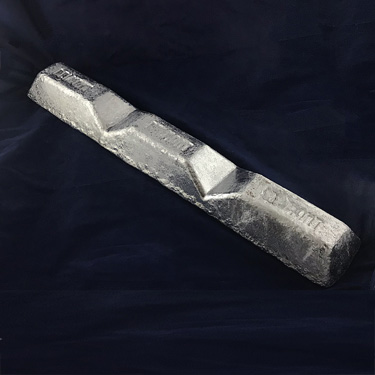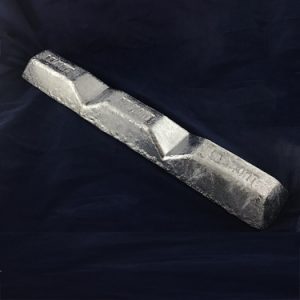When we think about aluminum, we most often associate this metal to the flexible foil used for everyday cooking. Yet this alloy can be used in applications where strength, corrosion resistance and weldability are required. The construction industry often uses aluminum alloys as beams, metal sheathing, and as scaffolding. This metal can also be used…
| Forms: |
|
|---|---|
| Belmont Product Code | 18912 |
| Nominal Composition: |
|
|---|
Downloads:
| SDS |
Related products
-
319 has excellent casting and machining characteristics. Corrosion resistance and weldability are very good and the mechanical properties are good. The anodized color is generally gray with a brown cast depending on the amount and ratio of silicon and copper. Typical applications for sand casting 319.0 are a wide variety of structural castings for engine parts, gas and oil pans, and general commercial applications.
Forms: - 22 Lb. Ingot
Belmont Product Code 10319 Nominal Composition: - 90.5% Al
- 3.5% Cu
- 6% Si
-
The 200-Series of Aluminum-Copper Alloys are well known for very high strength; nearly double that of the more common 300-Series of Aluminum-Silicon alloys. However, the 200 series can be very difficult to cast. These alloys should be considered where the strength vs. weight ratio is the key consideration such as in the Aerospace and Transportation sector.
Forms: - Ingot
- Sheared Pieces
- 16-17 Waffle
Belmont Product Code 19413 Nominal Composition: - 94% Al
- 4.5% Cu
- 0.7% Ag
- Bal
RELATED POSTS

Magnesium Elements: Providing Positive Benefits to Copper and Aluminum Alloys
Alloys on their own can offer a range of mechanical and structural benefits for manufacturers and other industries. Yet your application may require the alloy to have increased strength, workability, or ductility for the particular application. Magnesium is one of many chemical elements that becomes added to other alloys such as copper and aluminum to…

Silicon: Increasing the Properties of Aluminum and Copper Alloys
Copper and aluminum are used in a range of applications around the world. You can find aluminum as beverage cans, metal building sheets and storage tanks. Copper is often found in environments that are electrically conducive, as you may see it as wiring. You can also find copper in electronics and used as brass or…

Cold Working Aluminum Alloys
When considering working and manufacturing with metals, particularly with aluminum, the first thoughts are centered on the heating process with hot furnaces where the metal is heated to extremely high temperatures and then wrought or cast into form. However, there is another type of process to strengthen the metal that involves adding other alloys to…

Grain Refinement of Aluminium Alloys
Look around you. You live in a world that contains raw materials that are formed and produced into the products you use and the homes you live in. One of the most widely available metals in the world is aluminum. It is the second most abundant element in the environment as we use it in…

Custom creations
Aluminum master alloys help metallurgists fine-tune alloys to create materials that are stronger, lighter, and more easily processed Aluminum is the most abundant metallic element in the Earth’s crust—it’s even more common than Iron. In its pure form, though, it’s soft and malleable. It needs to be alloyed with other elements, including Iron, Zinc, Silicon,…
Solid structures
From everyday uses to extreme applications, Aluminum alloys get the job done Many people think of Aluminum in terms of crushable cans and foil, but, in addition to being lightweight, Aluminum’s strength and toughness is valuable when manufacturing cars, trucks and military vehicles. There are more than 500 recorded alloys that contain Aluminum, and because…

Light and strong
Aluminum alloys are essential to a wide variety of applications From planes to trains, cans and cars—when engineers are looking for a way to reduce weight but retain strength, they often turn to lightweight, durable Aluminum. The white metal only has been manufactured in commercial quantities for just over a century, largely due to the…


